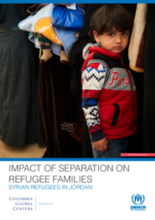EXECUTIVE SUMMARY
BACKGROUND
The ongoing conflict in Syria, now entering its eighth year, has resulted in the largest refugee crisis since World War II. Nearly 6.5 million Syrians have become internally displaced, with an additional 5.6 million forced to leave their country to seek asylum. In the face of this displacement, greater attention is being given to complementary and alternative solutions such as reunification of separated family members. However, serious legal and procedural obstacles are obstructing the reunification of Syrian families across the Middle East and Europe.
This study outlines several ways in which family separation negatively impacts Syrian refugees in Jordan. These effects are significant, and include financial burdens, increased child labour, emotional distress, broken social networks, parenting challenges and changes to familial roles.
MAIN THEMES
85 semi-structured, in-depth interviews were conducted in Jordan and analyzed to identify concepts central to understanding refugee experiences with family separation. The following are the five core themes that emerged:
1. Family separation occurs at distinct times during displacement and exhibits a shared pattern across the sample. Key moments of separation included immediately before leaving Syria and after residing in Jordan for a substantial period of time.
“We made the decision to leave. The house was destroyed. My parents-in-law told me to go and they will stay and will accept their fate. We went on the road and became hungry, everything happened to us on the road. But we arrived safely, thank God.” (dual head of household, arrived to Jordan in 2014)
2. Family separation has damaged or broken social connections and resulted in new and smaller networks, with less capacity to support one another. While all families expressed a combination of these challenges, families that were solely headed by women faced greater difficulty in several domains.
“We’re not able to teach them respect... Our values, principles and traditions - the Syrian ones, the ones we are proud of [are] almost being buried for the reason that everyone is in different countries. For example, my children have forgotten their grandparents…. They have no such thing as uncles or aunts at all. They don’t have any idea what that means.” (dual head of household, arrived to Jordan in 2013)
3. The absence of key family members exacerbates financial burdens in Jordan, resulting in increased stress, child labour, debt accumulation, and strained relationships with host communities.
“My children are responsible, they know the situation. We want to live and pay for the house. They never complain. The other boy [works at a] socks factory. His school refused to let him work. They said it’s either school or work. They told us the same thing last year. He left school this year because we needed money. He wants to return to school. He was so upset about leaving his school... I told him that I will go to work next year and let him go to school.” (female head of household, arrived to Jordan in 2014)
4. Admission and family reunification policies are keeping Syrian families apart. Even when Syrian refugees keep abreast of frequently changing requirements, the costs of most reunification processes are unaffordable. Respondents noted expenses related to documentation [and transportation] as being out of reach.
“Our papers are all in order. The delay is from them, not from us. The laws of the state itself. We only want them to permit family reunification, not for all the young men trying to enter... Everybody is trying. Many families here try to leave but are banned… The situation is very hard.” (dual head of household, arrived to Jordan in 2013)
5. Syrian refugee perceptions about durable solutions are greatly influenced by the location of family members. Indeed, the vast majority of Syrians interviewed in this study exuded a sense of stagnation as a result of being unable to reunify with separated family members or make concrete decisions about the future.
“If there is a country to reunify me with my husband and my daughters, I will go for sure. I will not say no.” (dual head of household, arrived to Jordan in 2014)
CONCLUSION
Many countries are providing support to Syrian refugees in accordance with customary international law obligations, as well as humanitarian principles and a regional legacy of protection. However, the current political climate has decreased states’ willingness to resettle or reunify separated refugee families. Reunification policies are also complex, frequently changing, limited to select familial relationships and out of reach for a substantial number of families. This study outlines critical ways in which family separation negatively impacts Syrian refugees in Jordan.
Responding to refugee crises is about saving lives, as well as helping those fleeing conflict thrive and contribute to the rebuilding of their future. Family reunification must be considered an essential component of complementary pathways, and obstacles preventing reunification need to be urgently addressed. Ensuring refugees’ right to family unity and streamlining reunification procedures is critical to refugee inclusion and family protection.

